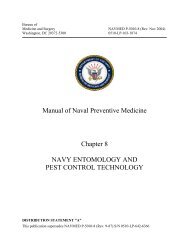ENVIRONMENTAL FINAL GOVERNING STANDARDS ITALY
ENVIRONMENTAL FINAL GOVERNING STANDARDS ITALY
ENVIRONMENTAL FINAL GOVERNING STANDARDS ITALY
Create successful ePaper yourself
Turn your PDF publications into a flip-book with our unique Google optimized e-Paper software.
<strong>ITALY</strong> - 6 Hazardous Waste<br />
C6.2.22. Non-hazardous Waste. Any waste that is not identified as hazardous by the<br />
USEUCOM Waste List, or through analysis as per Appendix B.1. The re-classification of<br />
hazardous waste to non-hazardous waste cannot be obtained by dilution or mixing with<br />
substances resulting in a reduction of the initial concentration of hazardous substances.<br />
C6.2.23. Packaging. Materials of any nature to be used for the containment, protection,<br />
handling, delivery and presentation of goods, from raw materials to processed goods. Items are<br />
considered to be packaging even if they may have other functions unless the item is an integral<br />
part of the product. Packaging components and ancillary elements integrated into packaging shall<br />
be considered to be part of the packaging into which they are integrated; for example labels,<br />
staples, plastic sleeves.<br />
C6.2.24. Persistent Organic Pollutants (POPs). Persistent Organic Pollutants are chemical<br />
substances that persist in the environment, bio-accumulate through the food web, and pose a risk<br />
of causing adverse effects to human health and the environment. This group of priority<br />
pollutants consists of pesticides (such as DDT), industrial chemicals (such as polychlorinated<br />
biphenyls), and unintentional by-products of industrial processes (such as dioxins and furan) as<br />
listed in Appendix B.6.<br />
C6.2.25. POL. Refined petroleum, oils and lubricants.<br />
C6.2.26. Scrap Vehicle. A motor vehicle or its parts (including tires) that the owner<br />
intends to or is required to dispose of.<br />
C6.2.27. Scrap Vehicle Collection Center. A (permitted) facility for the demolition and<br />
reclaiming operations for the crushing of parts of the vehicle being demolished, in order to obtain<br />
recyclable pieces of metal, separating them from non-metallic parts for recovery related energy<br />
savings, or disposal.<br />
C6.2.28. Service Solid Waste Management Manual. Naval Facility Manual of Operation<br />
(NAVFAC MO) 213, Air Force Regulation (AFR) 91-8, Army TM 5-634 (Solid Waste<br />
Management), or their successor documents.<br />
C6.2.29. Sludge. A special waste generated from drinking water or any other water<br />
treatment activities, from wastewater treatment activities, and from fumes abatement.<br />
C6.2.30. Special Waste. Any non-urban waste generated by the following activities:<br />
C6.2.30.1. Waste from agricultural and agricultural-industrial activities<br />
C6.2.30.2. Waste from demolition activities, construction, and excavation (see also<br />
Construction and Demolition Waste)<br />
C6.2.30.3. Waste from industrial activities (e.g., paint booth processes)<br />
C6.2.30.4. Waste from handicraft activities [e.g., Morale, Welfare and Recreation<br />
(MWR) hobby shops, car body shops, or wood carpentry shops]<br />
C6.2.30.5. Waste from commercial activities (e.g., commissaries, car repair shops, etc.)<br />
September 2012 Italy FGS 6-5<br />
Revision 0
















